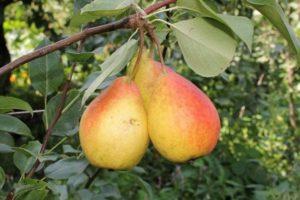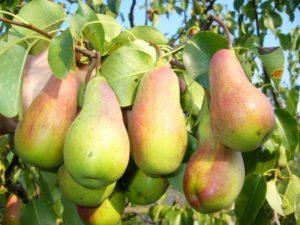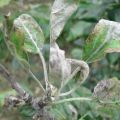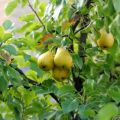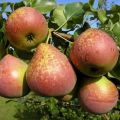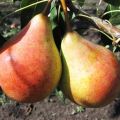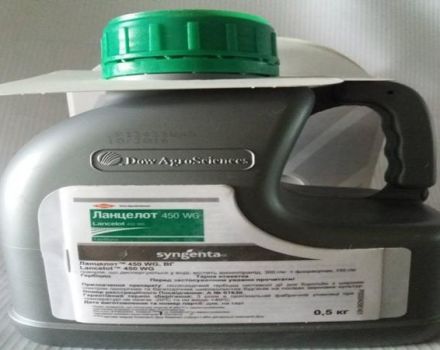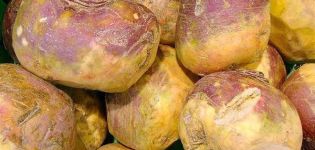Description of the best varieties of pears for the Moscow region, self-fertile, undersized and resistant to diseases
Some gardeners can boast of pear varieties for the Moscow region. Heat-loving trees give a stable yield of juicy fruits. But how to achieve sustainable fruiting? How to make a tree delight with fruit every year in an unstable climate? First of all, you should pay attention to the variety or hybrid. Many are zoned for the Moscow region and bear fruit successfully. And on others it is simply a pity to waste space in the garden.
Features of the climatic zone
The Moscow region is located in a zone of moderate continental climate. It is characterized by an uneven distribution of precipitation. It happens that the bulk falls in the fall or spring. And in summer there is a drought. At the beginning of winter, severe frosts are not uncommon, accompanied by a sharp northerly wind. And in late spring, return frosts come, when sub-zero temperatures are established for several days.
In such conditions, caring for a southern pear is quite difficult. The tree blooms early, and repeated spring frosts can prevent flowers from pollinating and destroy the ovaries.
Cultivation of the crop is difficult, since the fruit buds are laid in the previous summer and can freeze out in winter.
In conditions of a short warm period, it is recommended to plant early maturing and early-growing varieties and hybrids. They begin to give a stable harvest in the 3rd year of the tree's life in the garden.
Summer varieties
Summer varieties have a short growing season. They give early, fully ripe fruits. But their keeping quality is small: only 2-3 weeks.
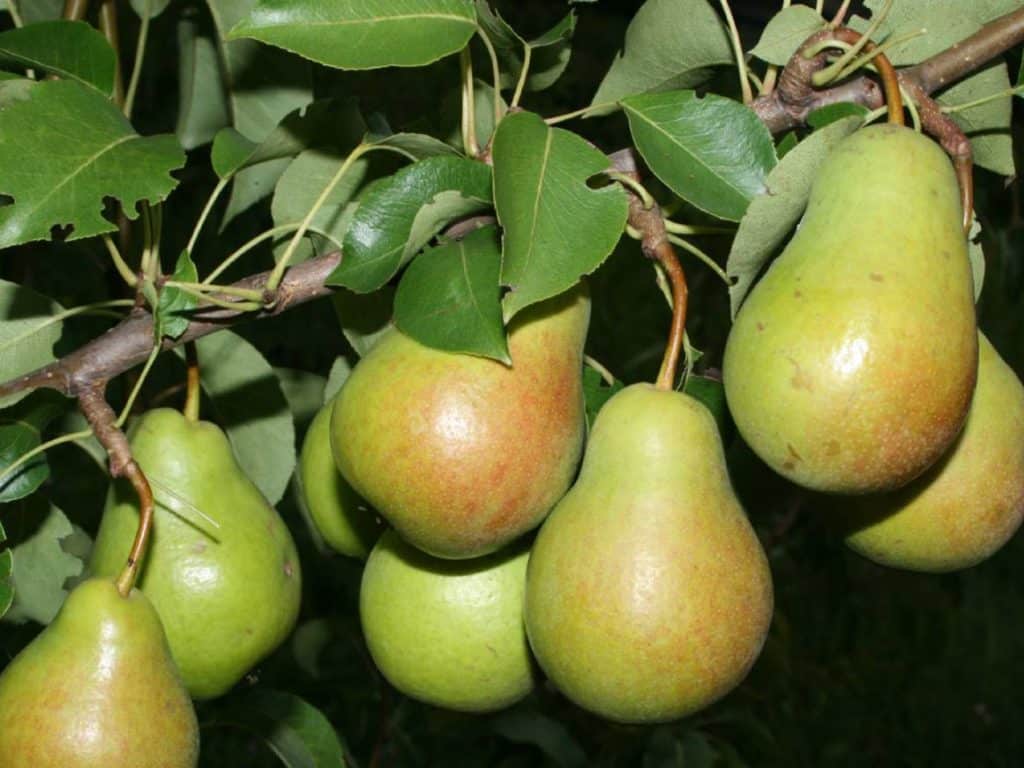
Lada
This is an old variety with medium-sized fruits (up to 110 g). Gardeners are attracted by:
- early maturity (the tree gives the first fruit after 3 years of life in the garden);
- self-pollination;
- scab resistance;
- frost resistance (fruit buds can withstand temperatures up to -25 ... -27 degrees);
- yield (30-40 kg per tree);
- sugary with sour taste of fruit.
But the variety also has disadvantages:
- low keeping quality of fruits (pears are stored for 2-2.5 weeks);
- thin skin impedes transportation;
- the pulp has a pronounced graininess;
- low juiciness of fruit.
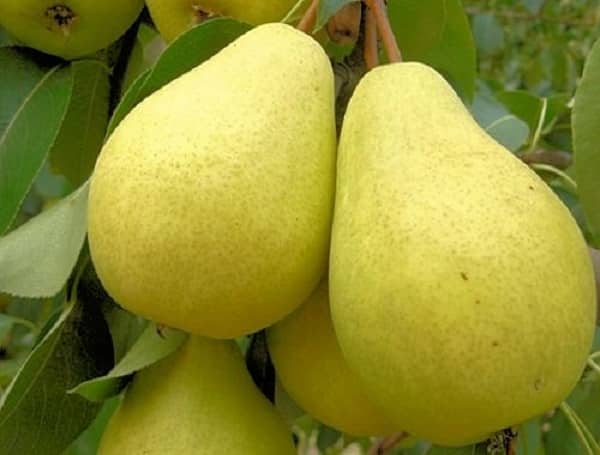
It is important to remember: the presence of a pollinator in the garden (Chizhovskoy, Rognedy) increases the fruiting of Lada by 20-30%.
Krasulia
In the garden you can often find Krasula with slightly ruddy fruits weighing up to 120 g. It is easy to identify it by its spreading crown and thorns on the branches and trunk. A tree grows up to 4 m.
Gardeners like:
- fruiting on the growth of the past and present years;
- sweet fruit taste (contains 11% sugars);
- resistance to major diseases and pests (scab, mite);
- winter hardiness (fruit buds do not freeze at -25 degrees).
But there are also disadvantages:
- too spreading crown (up to 4 m in girth);
- oily pulp consistency;
- low keeping quality.
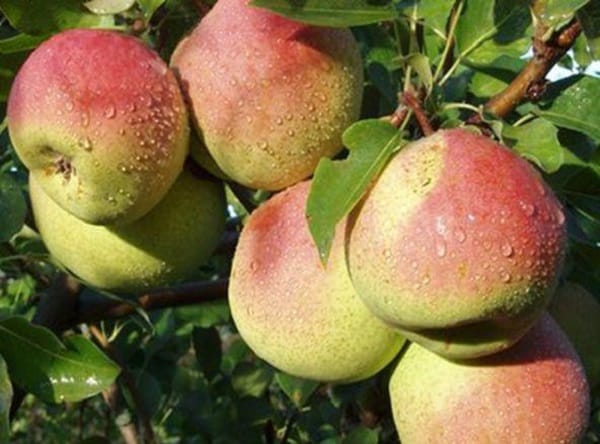
The fruit is delicious fresh. They ripen in the second decade of August.
August dew
The fruits ripen at the end of August. They have a sweet and sour taste and a slight graininess. Gardeners appreciate the variety for:
- resistance to scab and pests;
- early maturity (begins to bear fruit in the 3rd year of life in the garden);
- harmonious taste;
- yield (up to 15 kg per tree);
- compactness (rarely grows up to 2.5 m);
- resistance to fruit shedding.
Disadvantage: poor transportability due to thin skin and juicy pulp.
It is important to remember: a tree needs a pollinator. To do this, you should plant a tree in memory of Yakovlev nearby.

Cathedral
Tall tree (over 4 m) with a dense crown that requires regular lightening pruning. Gardeners believe that Cathedral Square is ideal for the Moscow Region. Its value:
- frost resistance (withstands short-term drops in temperature to -27 degrees);
- drought resistance;
- annual fruiting;
- good fruit taste (sweet with a sour aftertaste);
- resistance to diseases and pests.
The yield increases by 30-40% when planting a pollinator plant: Lada, Chizhevskaya.
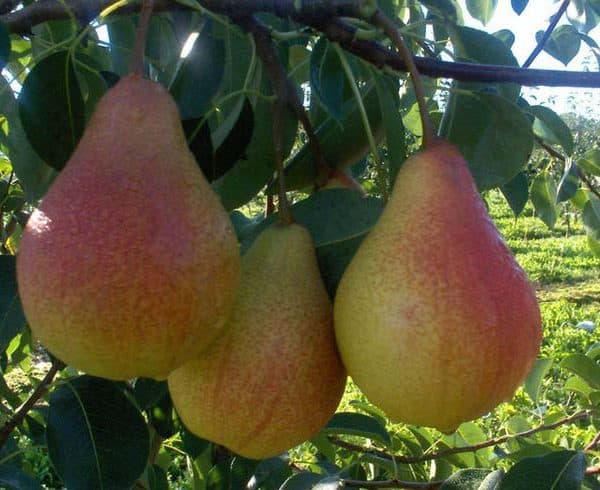
Chizhevskaya
This variety was the most widespread 10-15 years ago. Chizhevskaya could be found in every garden. The taste of the fruit is quite common: sourish, slightly sweet. The pulp is oily, white, granular. But gardeners appreciate the tree for:
- yield (regularly gives up to 60 kg per tree);
- early maturity (beginning of fruiting in the 3rd year of life in the garden);
- compactness (height of an adult pear 3 m);
- shatter resistance;
- frost resistance;
- drought resistance;
- fallen fruits do not deteriorate within 1-1.5 weeks.
The fruits make excellent compotes and jams.
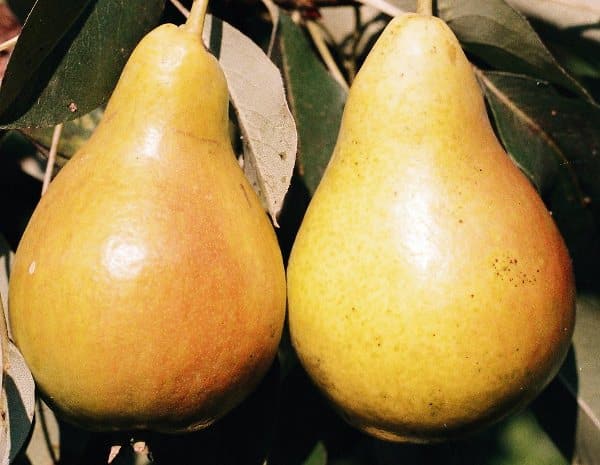
Autumn varieties
In the Moscow region, autumn varieties on a tree do not fully ripen: they are removed a little unripe. And then they arrive in a cool, dark place.
If properly stored, pears do not spoil until January.
Muscovite
A Muscovite should be planted in the country. It is undemanding to soil and light conditions. Wood value:
- early maturity;
- compactness (height up to 3 m, raised rounded crown);
- annual yield (up to 40 kg per tree);
- resistance to fruit shedding;
- winter hardiness (fruit buds are preserved at -27 degrees);
- sweet taste of fruits;
- keeping quality (up to 4 months);
- transportability;
- drought resistance;
- resistance to excessive overgrowth of the crown.
The fruits make excellent compotes, preserves and jams.

Red-sided
Red-sided grows on almost any soil. And she is undemanding to care. This tree grows more than 4 m. But the crown is resistant to fouling, therefore, lightening pruning is carried out every 2 years. Plant value:
- frost resistance;
- yield (up to 80 kg from 1 tree);
- scab resistance;
- large-fruited (pears reach 180 g);
- excellent taste (sweet, tart, improves after 3-4 days of maturation);
- keeping quality (fruits are stored until the New Year);
- yield (from 1 tree you can collect 1 centner of fruit);
- universal use of fruits.
But Red-sided is not fast-growing: it begins to bear fruit in the 7th year of life in the garden.
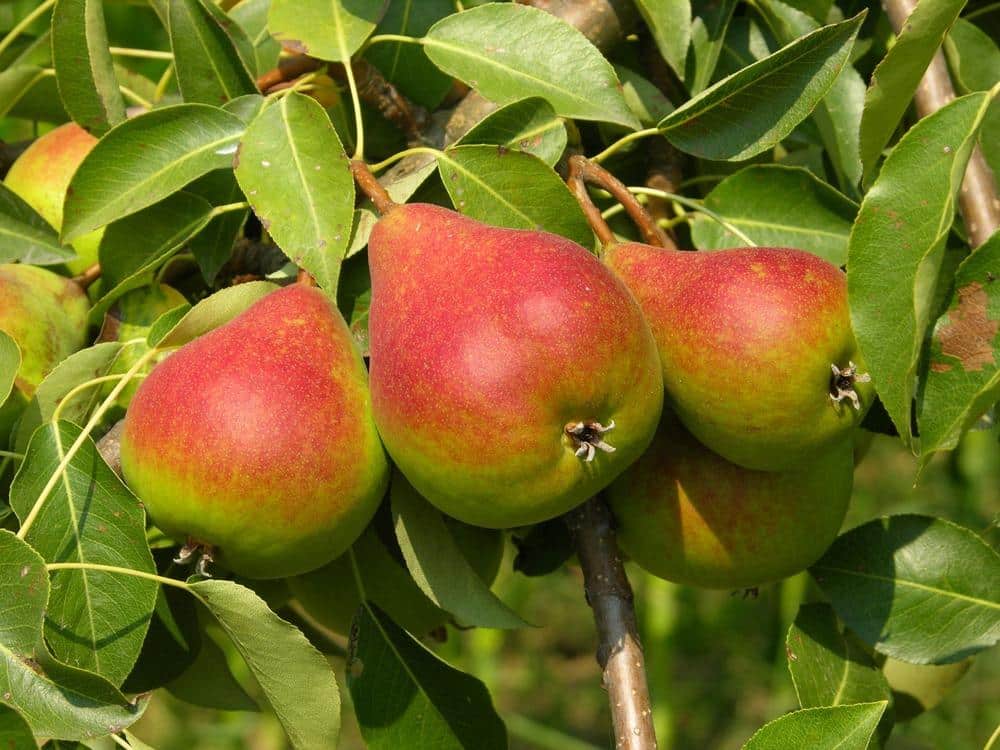
Elegant Efimova
Early autumn pear. It has very beautiful (ornate) fruits. The taste is sweet, according to the tasting assessment - 4.5 points out of 5 possible. The tree is frost-resistant, undemanding to soil, moisture and maintenance. Practically does not get sick and is not damaged by pests.
Hera
The tree has a pyramidal crown. There is practically no thickening. Variety value:
- frost resistance;
- excellent taste and texture of the fruit;
- long shelf life (up to 5 months);
- shatter resistance;
- transportability;
- large-fruited (up to 200 g);
- quick restoration of the crown after freezing.
Hera is resistant to fungi and bacterial infections.

Yakovlev's favorite
Yakovlev's favorite is appreciated for the quince fruit aftertaste. Advantages:
- winter hardiness;
- taste;
- the beauty of the fruits (yellow-pink, ruddy);
- yield (increases with age).
But the Darling is not quick-growing: the gardener receives the first fruits in the 7th year of the tree's life in the garden.
Fabulous
The pear is distinguished by its large fruits (up to 250 g). It is practically not affected by scab and mites. The fruits are great for making mashed potatoes, jams. Of the shortcomings of the Fairy-tale gardeners, they note a high crown, from which it is difficult to remove ripe fruits.

Winter varieties
Winter, or late, varieties do not ripen in the Moscow region. The fruits are picked green and kept in the pantry. These hardy trees attract gardeners with the taste and shelf life of the fruit.
Miracle woman
Breeders got this hybrid as a result of crossing the Daughter of Dawn and the Talgar beauty. The hybrid has a pyramidal crown that is resistant to overgrowth. The miracle is different:
- disease resistance;
- stable yield;
- sweet fruit taste.
Pears weigh up to 210 g. They lie until the New Year.
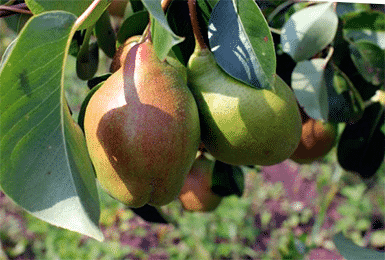
Extravaganza
This is the best selling pear. Extravaganza value:
- shatter resistance;
- keeping quality;
- yield;
- resistance to diseases and pests.
The fruits have a universal purpose: they are pleasant to eat fresh, and the preparations delight with a refreshing taste.

Novella
The novella was obtained as a result of crossing Bere winter Michurin and Svetlyanka. The tree is spreading, high (up to 4 m). Variety advantages:
- winter hardiness (withstands frosts down to -33 degrees);
- early maturity;
- resistance to fungal diseases;
- stable yield;
- large-fruited (up to 180 g);
- excellent taste and consistency of fruits (4.3 points out of 5).
In the gardens of the Moscow region, the variety is rarely found.

Nika
The variety was obtained by crossing the Talgar Beauty and the Daughter of Dawn. From his parents he received the following dignity:
- large-fruited (up to 200 g);
- good taste (sweet and sour);
- yield;
- frost resistance (up to -30 degrees);
- transportability;
- keeping quality.
Of the shortcomings, gardeners note a sprawling spherical crown.
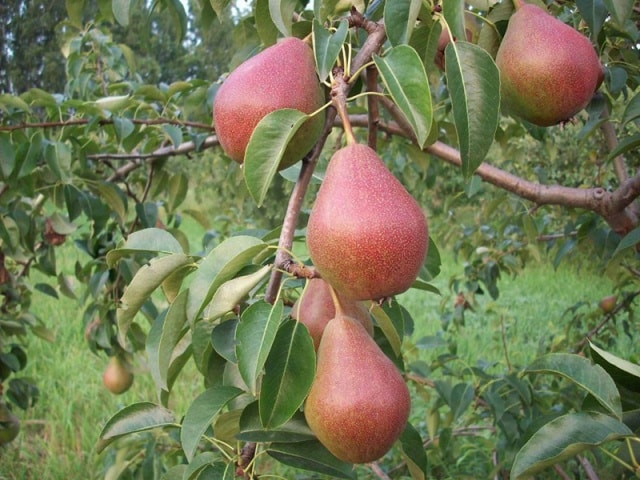
Belarusian late
Gardeners speak about the Belarusian late with delight. The value lies in:
- winter hardiness;
- unpretentiousness;
- compactness;
- yield;
- great taste;
- stable fruiting;
- high transportability;
- keeping quality.
But the gardener receives the first harvest in the 6th year after planting pears in the garden.
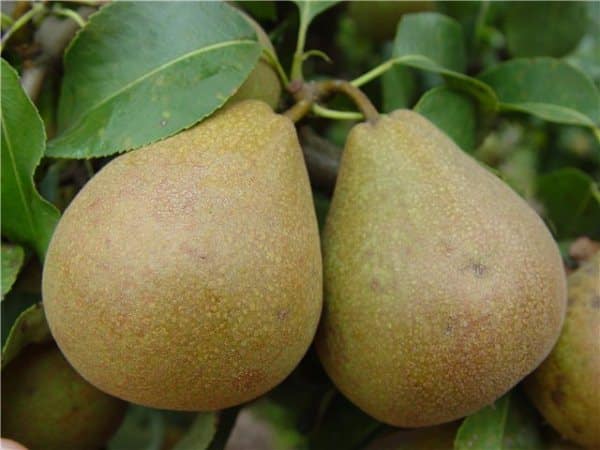
The best sweet pear varieties
Ripe pear contains a large amount of sugars, which means it has a sweet taste. But some varieties, even unripe, are the most delicious. Some of them can be grown in the Moscow region:
- Autumn sweet;
- Oily sweet;
- Prominent (Bumpy).
These varieties will delight the sweet tooth with an excess of sugars.
Disease resistant varieties
Breeders are constantly improving the characteristics of pears. They create highly immune strains that do not suffer from disease. Demonstrate resistance to rust:
- August dew;
- Duhmyanaya;
- Wizard;
- In memory of Yakovlev.
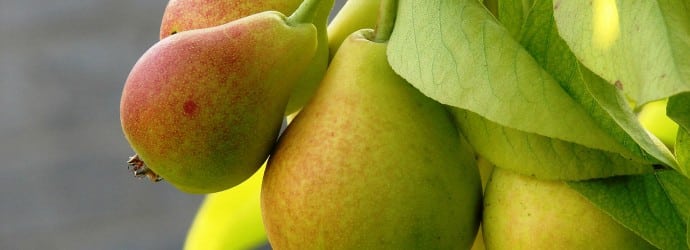
These trees are zoned for the Moscow region.
Columnar varieties for the Moscow region
Columnar pears are increasingly chosen by gardeners of the Moscow region. The reasons are obvious:
- undersized trees;
- the crown is compact, pyramidal;
- early-growing pears.
And even relatively low, compared to classic varieties, the yield is not an obstacle to purchase. The dwarf pear is increasingly found in gardens near Moscow.
What varieties are recommended for planting:
- early winter Dalikor;
- summer decor;
- summer Carmen;
- Honey.

But it is important to consider: columnar varieties age and stop bearing fruit faster than classic ones.
Self-fertile varieties
Pear is a self-fertile tree, that is, it requires a pollinator. This is a variety or hybrid that blooms at the same time as the purchased variety. But recently, self-pollinated varieties and hybrids have become popular. In the Moscow region, it is recommended to plant:
- Lada;
- Krasul;
- August dew;
- Red-sided;
- Muscovite;
- Elegant Efimova.
But it is important to remember: the presence of a pollinator will increase yields by 20-30%.
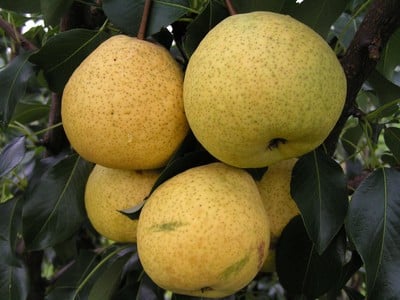
Modern varieties
Breeders are working to improve the characteristics of pears. New varieties and hybrids appear. But they do not come on wide sale soon: tests take a lot of time. In the early 2000s, the State Register for the Central District included:
- Faithful;
- Thumbelina.
These trees are recommended for growing in the Moscow region.
Recommendations when choosing seedlings
Gardeners should remember:
- it is better to plant a pear in the spring (it will have time to build up the root system for winter);
- the plant should have a fibrous system and 1-2 chopped tap roots (when purchasing seedlings with an open root system);
- the pear must be planted in a pre-prepared pit;
- the plant should be tied to a peg and shaded.
The place for the pear should be closed from cold northerly and northeasterly winds.
